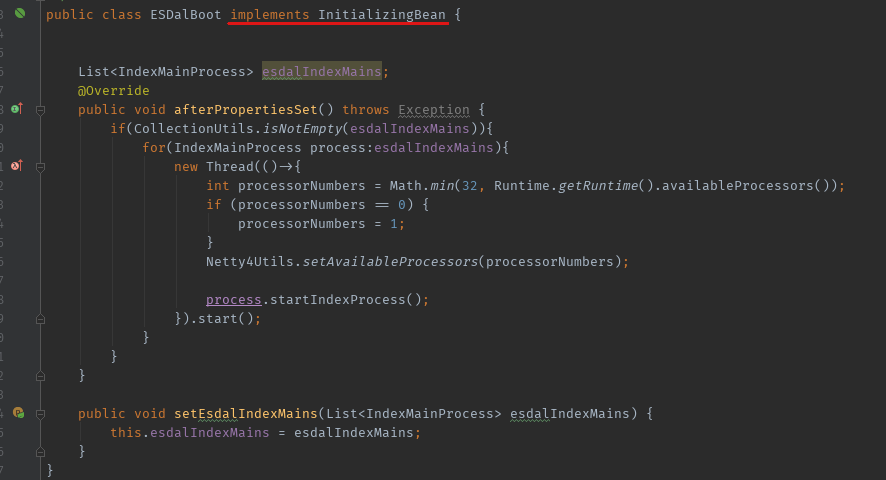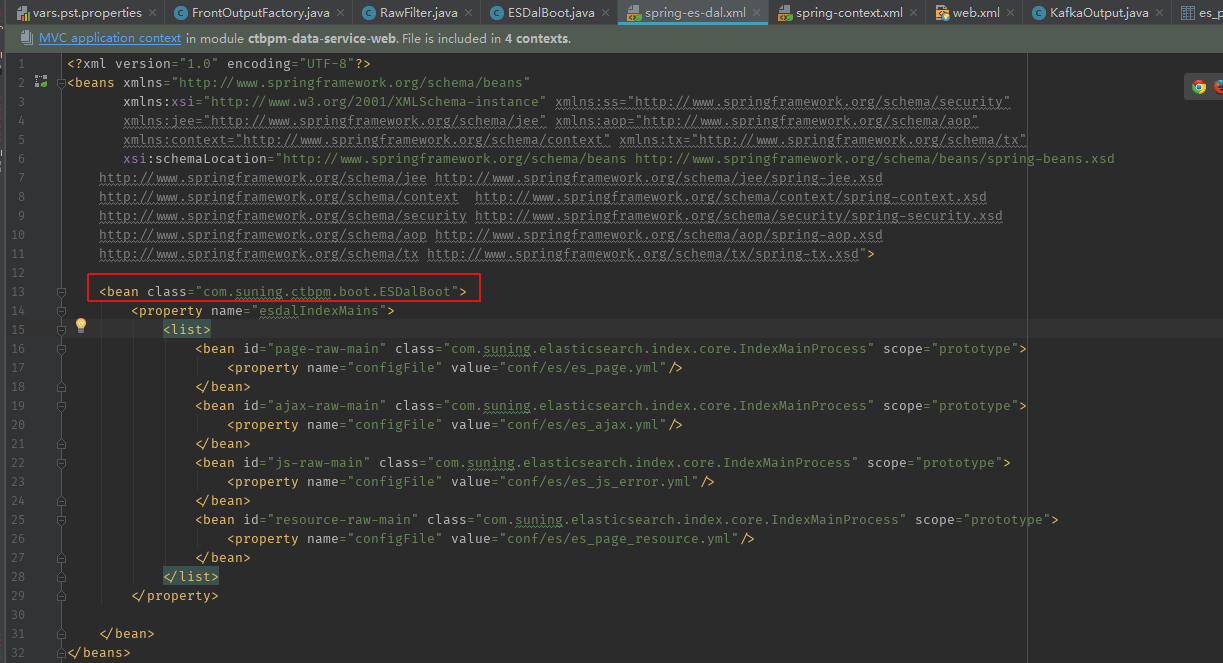Spring Bean InitializingBean和DisposableBean实例
今天在看代码的时候遇到了一个代码块:




ESDalBoot实现了InitializingBean,先研究InitializingBean接口:
测试程序如下:
import org.springframework.beans.factory.InitializingBean; public class TestInitializingBean implements InitializingBean{ @Override public void afterPropertiesSet() throws Exception { System.out.println("ceshi InitializingBean"); } public void testInit(){ System.out.println("ceshi init-method"); } }
<?xml version="1.0" encoding="UTF-8"?> <beans xmlns="http://www.springframework.org/schema/beans" xmlns:context="http://www.springframework.org/schema/context" xmlns:jdbc="http://www.springframework.org/schema/jdbc" xmlns:xsi="http://www.w3.org/2001/XMLSchema-instance" xmlns:p="http://www.springframework.org/schema/p" xmlns:aop="http://www.springframework.org/schema/aop" xmlns:tx="http://www.springframework.org/schema/tx" xsi:schemaLocation=" http://www.springframework.org/schema/beans http://www.springframework.org/schema/beans/spring-beans-3.0.xsd"> <bean id="testInitializingBean" class="com.TestInitializingBean" ></bean> </beans>
Main主程序如下:
public class Main { public static void main(String[] args){ ApplicationContext context = new FileSystemXmlApplicationContext("/src/main/java/com/beans.xml"); } }
ceshi InitializingBean
这说明在spring初始化bean的时候,如果bean实现了InitializingBean接口,会自动调用afterPropertiesSet方法。
问题:实现InitializingBean接口与在配置文件中指定init-method有什么不同?
修改配置文件,加上init-method配置,修改如下
<?xml version="1.0" encoding="UTF-8"?> <beans xmlns="http://www.springframework.org/schema/beans" xmlns:context="http://www.springframework.org/schema/context" xmlns:jdbc="http://www.springframework.org/schema/jdbc" xmlns:xsi="http://www.w3.org/2001/XMLSchema-instance" xmlns:p="http://www.springframework.org/schema/p" xmlns:aop="http://www.springframework.org/schema/aop" xmlns:tx="http://www.springframework.org/schema/tx" xsi:schemaLocation=" http://www.springframework.org/schema/beans http://www.springframework.org/schema/beans/spring-beans-3.0.xsd"> <bean id="testInitializingBean" class="com.TestInitializingBean" init-method="testInit"></bean> </beans>
在配置文件中加入init-method="testInit"。
运行Main程序,打印如下结果:
ceshi InitializingBean
ceshi init-method
由结果可看出,在spring初始化bean的时候,如果该bean是实现了InitializingBean接口,并且同时在配置文件中指定了init-method,系统则是先调用afterPropertiesSet方法,然后在调用init-method中指定的方法。
这方式在spring中是怎么实现的?
通过查看spring的加载bean的源码类(AbstractAutowireCapableBeanFactory)可看出其中奥妙
总结:
1:spring为bean提供了两种初始化bean的方式,实现InitializingBean接口,实现afterPropertiesSet方法,或者在配置文件中同过init-method指定,两种方式可以同时使用
2:实现InitializingBean接口是直接调用afterPropertiesSet方法,比通过反射调用init-method指定的方法效率相对来说要高点。但是init-method方式消除了对spring的依赖
3:如果调用afterPropertiesSet方法时出错,则不调用init-method指定的方法。
4:TransactionTemplate实现InitializingBean接口,主要是判断transactionManager是否已经初始化,如果没有则抛出异常。源码如下:
这方式在spring中是怎么实现的?
通过查看spring的加载bean的源码类(AbstractAutowireCapableBeanFactory)可看出其中奥妙
protected void invokeInitMethods(String beanName, final Object bean, RootBeanDefinition mbd) throws Throwable { //判断该bean是否实现了实现了InitializingBean接口,如果实现了InitializingBean接口,则只掉调用bean的afterPropertiesSet方法 boolean isInitializingBean = (bean instanceof InitializingBean); if (isInitializingBean && (mbd == null || !mbd.isExternallyManagedInitMethod("afterPropertiesSet"))) { if (logger.isDebugEnabled()) { logger.debug("Invoking afterPropertiesSet() on bean with name '" + beanName + "'"); } if (System.getSecurityManager() != null) { try { AccessController.doPrivileged(new PrivilegedExceptionAction<Object>() { public Object run() throws Exception { //直接调用afterPropertiesSet ((InitializingBean) bean).afterPropertiesSet(); return null; } },getAccessControlContext()); } catch (PrivilegedActionException pae) { throw pae.getException(); } } else { //直接调用afterPropertiesSet ((InitializingBean) bean).afterPropertiesSet(); } } if (mbd != null) { String initMethodName = mbd.getInitMethodName(); //判断是否指定了init-method方法,如果指定了init-method方法,则再调用制定的init-method if (initMethodName != null && !(isInitializingBean && "afterPropertiesSet".equals(initMethodName)) && !mbd.isExternallyManagedInitMethod(initMethodName)) { //进一步查看该方法的源码,可以发现init-method方法中指定的方法是通过反射实现 invokeCustomInitMethod(beanName, bean, mbd); } } }
总结:
1:spring为bean提供了两种初始化bean的方式,实现InitializingBean接口,实现afterPropertiesSet方法,或者在配置文件中同过init-method指定,两种方式可以同时使用
2:实现InitializingBean接口是直接调用afterPropertiesSet方法,比通过反射调用init-method指定的方法效率相对来说要高点。但是init-method方式消除了对spring的依赖
3:如果调用afterPropertiesSet方法时出错,则不调用init-method指定的方法。
4:TransactionTemplate实现InitializingBean接口,主要是判断transactionManager是否已经初始化,如果没有则抛出异常。源码如下:
public void afterPropertiesSet() { if (this.transactionManager == null) { throw new IllegalArgumentException("Property 'transactionManager' is required"); } }
扩展:
Spring Bean InitializingBean和DisposableBean实例
在Spring中,InitializingBean和DisposableBean是两个标记接口,为Spring执行时bean的初始化和销毁某些行为时的有用方法。
-
对于Bean实现 InitializingBean,它将运行 afterPropertiesSet()在所有的 bean 属性被设置之后。
-
对于 Bean 实现了DisposableBean,它将运行 destroy()在 Spring 容器释放该 bean 之后。
示例
下面是一个例子,向您展示如何使用 InitializingBean 和 DisposableBean。一个 CustomerService bean来实现 InitializingBean和DisposableBean 接口,并有一个消息(message)属性。
package com.yiibai.customer.services; import org.springframework.beans.factory.DisposableBean; import org.springframework.beans.factory.InitializingBean; public class CustomerService implements InitializingBean, DisposableBean { String message; public String getMessage() { return message; } public void setMessage(String message) { this.message = message; } public void afterPropertiesSet() throws Exception { System.out.println("Init method after properties are set : " + message); } public void destroy() throws Exception { System.out.println("Spring Container is destroy! Customer clean up"); } }
File : applicationContext.xml
<beans xmlns="http://www.springframework.org/schema/beans" xmlns:xsi="http://www.w3.org/2001/XMLSchema-instance" xsi:schemaLocation="http://www.springframework.org/schema/beans http://www.springframework.org/schema/beans/spring-beans-2.5.xsd"> <bean id="customerService" class="com.yiibai.customer.services.CustomerService"> <property name="message" value="I'm property message" /> </bean> </beans>
执行它
package com.yiibai.common; import org.springframework.context.ConfigurableApplicationContext; import org.springframework.context.support.ClassPathXmlApplicationContext; import com.yiibai.customer.services.CustomerService; public class App { public static void main( String[] args ) { ConfigurableApplicationContext context = new ClassPathXmlApplicationContext(new String[] {"applicationContext.xml"}); CustomerService cust = (CustomerService)context.getBean("customerService"); System.out.println(cust); context.close(); } }
该ConfigurableApplicationContext.close()将关闭该应用程序的上下文,释放所有资源,并销毁所有缓存的单例bean。它是只用于 destroy() 方的演示目的。
输出结果
Init method after properties are set : I'm property message com.yiibai.customer.services.CustomerService@4090c06f Spring Container is destroy! Customer clean up
afterPropertiesSet()方法被调用在 message 属性设置后,而 destroy()方法是在调用 context.close()之后;
建议:
不建议使用InitializingBean和DisposableBean的接口,因为它将你的代码紧耦合到 Spring 代码中。 一个更好的做法应该是在bean的配置文件属性指定 init-method和destroy-method。
不建议使用InitializingBean和DisposableBean的接口,因为它将你的代码紧耦合到 Spring 代码中。 一个更好的做法应该是在bean的配置文件属性指定 init-method和destroy-method。





